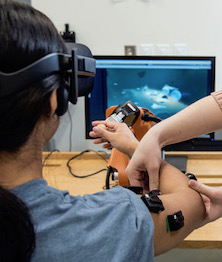Citlali López-Ortiz
 Force Feedback of Low Dimensions in Virtual Reality for Movement Rehabilitation and Characterization in Cerebral Palsy
Force Feedback of Low Dimensions in Virtual Reality for Movement Rehabilitation and Characterization in Cerebral Palsy
Cerebral palsy (CP) is the most common developmental motor disorder in children. Individuals with CP demonstrate abnormal muscle tone and motor control. These neurological impairments manifest at an early age and tend to worsen with time. The main goals of rehabilitation in CP include physical therapy interventions that consist mainly of intensive stretching and strengthening exercises and more recently, high dosage robotic training aimed at restoring locomotion, reaching ability, and ankle mobility. However, meaningful clinical improvements are limited for children with dystonic movements.
Professor López-Ortiz hypothesizes that motor learning of force efforts using feedback in low dimensional visual mappings will facilitate arm movements in children with dystonia and with combinations of dystonia and spasticity. As the child generates force against a robot, she receives real time feedback of the forces and torques generated in a lower dimension virtual reality game (VR). The child in training must learn implicitly which muscle activation patterns successfully match the mapped force targets in the VR game. Since there is redundancy in the solutions due to the reduction of dimensions in the feedback space, the child with CP can successfully match targets with atypical solutions. This game-like intervention will also provide an objective and quantitative characterization of dystonia and spasticity through principal component analysis of the forces, torques, and muscle activity patterns generated in learning to play the game.
